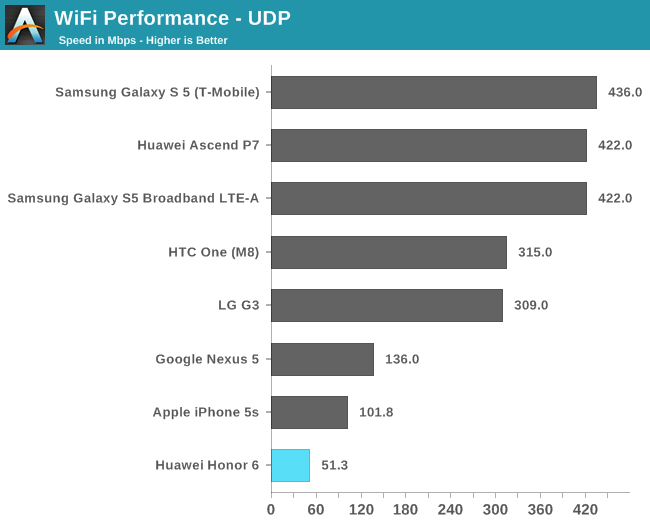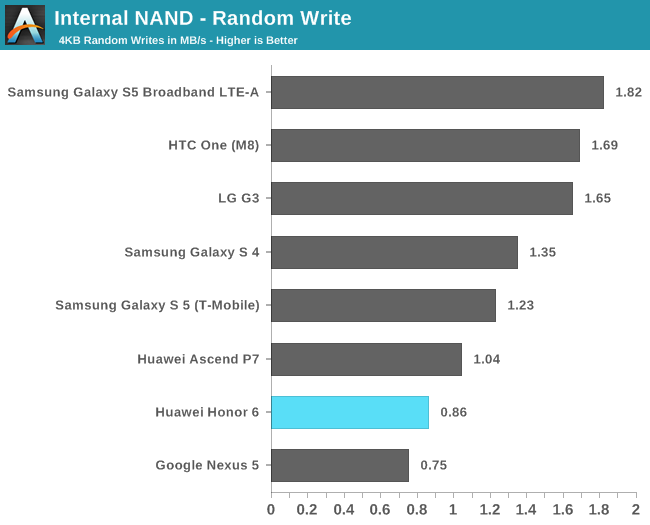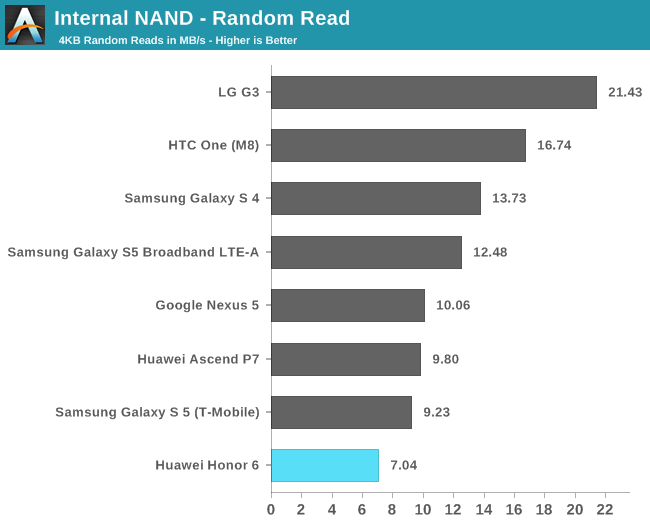Huawei Honor 6 Review
by Andrei Frumusanu & Joshua Ho on September 12, 2014 9:00 AM EST- Posted in
- Smartphones
- Huawei
- Android
- Mobile
- Honor 6
WiFi Performance
Out of all the benchmarks that we’ve ran on the Honor 6, there is one that really stands out more than anything else. The phone has one of the worst performing WiFI systems that we’ve ever tested. Coming at a top speed of 52mbps on our test bench, the device lags far behind not only other flagships, but other smartphones period.

What really is happening here is a mystery to both me and Josh. We find a BCM4334 chipset in charge of the connectivity and it is, similarly to Samsung’s Exynos series interfaced via an SDIO bus. My first suspicion was that maybe the bus bandwidth to the DWMMC controller was misconfigured, but I have no evidence of this without the kernel sources being available. This leaves the possibility that the antenna is just badly designed and has unfavorable RF characteristics such as significant impedance mismatch/high SWR. In fact this can be more or less observed as the phone has a bit of a death-grip issue regarding WiFi strength when you cover up the top part of the device. Reception is so bad that I’ve found myself losing connectivity to my router when walking around the house. Whatever the cause may be, this is easily such a negative aspect of the device that it may very well be the deciding factor for many buyers.
NAND Performance
The internal eMMC NAND storage of a phone can be a crucial factor in a device's performance. Inside the Huawei we find a Toshiba 16GB NAND chip with the system and data partitions running on an ext4 filesystem.




The performance is one of the lowest ones we find in the current-generation phones as Huawei skimped on the eMMC chip as it is outperformed by a factor of two or three by other smartphones. This is the same class model that you could find in some Galaxy S3 variants and other phones over 2.5 years ago. Only Huawei's own Ascend P7 performs worse.
The Honor 6 offers also a microSD card slot in case you want to expand your storage. The OS offers full exFat compatibility and I had no issues with my Samsung Pro 64GB card. I was however disappointed to see that the HiSilicon chip suffers from the same limitation that plagues other SoCs for no good reason: the DWMMC controller in charge of the SD-card is limited to SDR50 speeds, meaning that you won't be able to exceed ~35mB/s transfer speeds on your microSD, no matter how fast it actually is. It still baffles me that OEMs refuse to address this even almost 2 years after the first UHS-1 cards have been made widely available.
Next, let's look at the camera system of the Honor 6.










59 Comments
View All Comments
DIYEyal - Saturday, September 13, 2014 - link
I found a typo in the battery life page: "I think this is due the phone having quite good thermal dissipation charateristics ."akshayprbhu - Friday, October 10, 2014 - link
that is not a typo. The phone is having good thermal dissipation as it is cooler than similar spec phones when a performance test was done! Youtube for more proof...lilmoe - Saturday, September 13, 2014 - link
Great review of what really matters. I especially liked the in-depth analysis of the SoC and its platform power in comparison to others. Looking forward to future reviews."Ideally, it would be interesting to see a 720p mode on 1440p screens as it would offer perfect scaling, with one logical pixel being mapped to exactly four physical ones, without the need for interpolation and upscaling artifacts"
If Samsung ever decides to put a 1440p panel on the GS6, I seriously hope they allow a 720p mode in their power saving options. Even if pentile, It would be MUCH sharper than any other 720p AMOLED panel since it's up-scaled. Actually, I seriously interested to see how it would look like. Plus, the added performance and battery life would be legendary on a phone faster and more efficient than the current GS5. Totally intriguing.
lilmoe - Saturday, September 13, 2014 - link
Oh, this is just a suggestion. If you must use browser benchmarks to measure platform performance (sighs...), wouldn't it be better to use the stock browser since it's what most people use? You know, since the stock browser is usually more optimized for that specific device and generally performs better than Chrome. Using Chrome to see the difference of Android devices in comparison is OK since they'd be using the same browser running on the same OS, but definitely NOT OK in comparison with other platforms.Please correct me if I'm wrong, because I'm positive that I'm not.
aryonoco - Sunday, September 14, 2014 - link
Thanks for the great review, this was the first time that any publication has exposed the inner workings of a Hisilicon SoC, and you've done a great job of that. However I wanted to mention here that I strongly disagree with your analysis of the software.Designing software that's going to be used by mass users is a constant balancing act between exposing enough power to satisfy different user requirements and power users, and yet keeping the UI simple enough so that the vast majority of users are not overwhelmed by the array of features. The Permission Management feature here, similar to those baked into many custom ROMs goes well over the line and is a huge user experience disaster. To ship an OEM ROM with this, is begging for a deluge of support calls from clueless customers who have disabled things and then wonder why their phone doesn't work as intended.
I'm not saying that the current permission management scenario in Android is perfect, far from it. I don't think anyone has figured out the perfect balance of how to inform users about third party apps without scaring them, turning the notices meaningless, or overwhelming users.
One of Anand's greatest assets was his ability to articulate his vision of good UI in various products. Him and Brian could explain why certain choices were made (for example in terms of treatment of external storage on Android, or the design tradeoffs about non-replaceable batteries) and the guiding principles behind them. File managers are archaic and confusing to 90% of users. I know the tech-savvy AT readership will disagree, but the whole concept of files and directories are broken for average users, especially on a device like a phone, and they are better off being abstracted away from them. Your comments on file managers in KitKat, or your praise of Huawei's software "enhancements" shows a lack of understanding of where the line is when it comes to UX design.
I hope that now that Anand is gone, AT doesn't become a place where the writers are blind to the needs of average customers. We do not need Android to regress to the wild days of Gingerbread, or worse, Windows Mobile.
Ethos Evoss - Sunday, September 14, 2014 - link
Well, you complaining about huawei logo or writing missing and main thing is that you NEVER complained on iphones that they NEVER put writing on their phones but that is alright ? h ? people are so pathetic .. if apple wud make soome plastic dick sticking out from phone you guys would say that is fine bcos it is iphone and we will forgive that we will get used to it .. oohh jeezz naive peopleakshayprbhu - Friday, October 10, 2014 - link
the writings are a part of the mandatory regulations to denote the compliance with the telecom regulations. and it does not eat up too much space on the back.darkich - Sunday, September 14, 2014 - link
Absolutely great analysis. Andrei and Joshua, keep these top notch write ups coming!SeleniumGlow - Monday, September 15, 2014 - link
I was hoping that the Kirin processor would have a comparison with the MediaTek MT6592. But I guess there are some obvious differences in the Big Little implementation that will prevent it from being a good comparison.siberstorm - Monday, September 15, 2014 - link
The mediocre camera and obvious cutrate shoddiness (wtf the stabilization is just the 1080p field cut down to 720p with none of the rest of the sensor used, so ghetto) is unacceptable and this goes for the mate 7 as well. So bye bye huawei. I am still interested in the lenovo vibe z2 pro aka k920 and would love a review of that phone, but the chances of lenovo sending one to anandtech are slim, considering they arent gunning for the global market like huawei is.